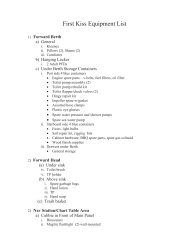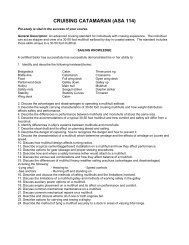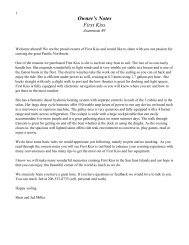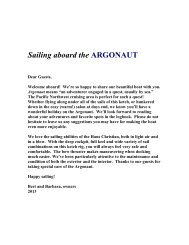Hunter 356 âISLAND ESCAPEâ Owner's Notes - San Juan Sailing
Hunter 356 âISLAND ESCAPEâ Owner's Notes - San Juan Sailing
Hunter 356 âISLAND ESCAPEâ Owner's Notes - San Juan Sailing
Create successful ePaper yourself
Turn your PDF publications into a flip-book with our unique Google optimized e-Paper software.
To Furl the Main Sail:<br />
Head the boat to a close reach course in order to get a nice tight wrap on the in-mast furling.<br />
Close the “Endless Loop (blue line) clam cleat closest to the companionway hatch. See point 2 above<br />
regarding the bulky splice in the blue line potentially jamming at the clam cleat.<br />
Put a wrap around the primary winch with the Clew Outhaul to keep it taut.<br />
Open the outer blue line Clam Cleat.<br />
Begin pulling the “Endless Loop” blue line at the inner Clam Cleat. This will pull the sail back into the<br />
mast.<br />
To Reef the Main Sail:<br />
The Mainsail may be reefed at any intermediate position by first setting the Reefing Winch to “FREE”<br />
and then carefully slacken off the outhaul line. Continue easing off the Clew Outhaul to roll in the desired<br />
amount of sail. The leach should be kept fairly taught. Keep slight tension on the outhaul to do this. Use<br />
the Primary Winch to take up the slack on the Endless Loop. When the desired amount of sail is rolled in,<br />
use the clew outhaul to stretch the foot of the sail. Make both ‘sides’ of the “Endless” reefing line fast to<br />
prevent slip on the Reefing Winch. If reefing from the mast, activate the lock (Ratchet”) on the Reefing<br />
Winch before reefing the sail. Use a winch handle, but NEVER leave the handle in the Winch!<br />
As noted, the mainsail Reefing Winch has a lever with two settings on it: “ratchet” and “free”. In higher<br />
wind situations this lever will need to be set to “ratchet” to help hold the mainsail in a reefed position and<br />
reduce stress on the Primary Winch. You will find a slight difference in operation between the “free”<br />
position and the “ratchet” position. In the “free” position the continuous furling line will work in both<br />
directions to furl the mainsail. In the “ratchet” position the “Endless” furling line will only furl in one<br />
direction. When leaving the boat, always lock the Reefing Winch to help reduce sail flutter.<br />
Jib Sail<br />
To Deploy the Jib Sail:<br />
Point the boat directly into the wind. In mild winds, the Jib may also be deployed (and furled) while on a<br />
normal course. The crew should adjust the jib sheet to keep the clew under control while setting the sail.<br />
Release the jib roller furling line (starboard yellow line attached to right of cockpit)<br />
Pull on the jib sheets. and sail your proper course!<br />
To Furl the Jib Sail:<br />
Point the boat directly into the wind, or in mild conditions maintain a steady course.<br />
Pull the jib roller furling line<br />
Keep gentle pressure on the jib sheet so the headsail will furl tightly<br />
Tie off the roller furling line.<br />
SHOWER<br />
Hot water is stored in the insulated 6 gallon tank located under the aft bed. It takes about 30 minutes of<br />
running the engine under load to get hot water. When on shore power, you can switch on the AC (120 V)<br />
switch on the electrical panel to heat your water electrically (also in about 30 minutes). Experienced<br />
cruisers adhere to the sailor’s shower: “get wet, turn it off, soap up, rinse off”.<br />
Be sure to turn the sump pump on at the DC electric panel. CAUTION: the engine can heat the water to<br />
scalding temperatures! On warm, sunny days, an alternative to the below deck shower is the swim<br />
platform shower. This is also a good way to rinse off salt after swimming or dirt after going ashore.<br />
‐ 20 ‐








